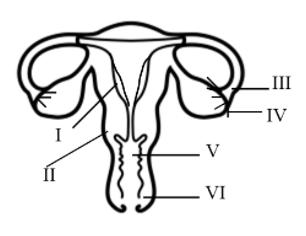
The given figure depicts a diagrammatic sectional view of the human female reproductive system. Which set of three parts is correctly identified?
A) (ii)Endometrium (iii) Infundibulum (iv) Fimbria
B) (iii) Infundibulum (iv)Fimbriae (v) Cervix
C) (iv)Oviduct funnel (iv)Uterus (v) Cervix
D) (i)Perimetrium (ii)Myometrium(iii)Fallopian tube


Answer
427.5k+ views
Hint: The Fallopian tubes, also known as uterine tubes. These are are the female structures that transport the ova from the ovary to the uterus each month. Each oviduct is suspended by mesosalpinx and is differentiated into three parts.
Complete answer:
The part of the oviduct closer to the ovary in the funnel-shaped infundibulum. The edges of the infundibulum have certain finger-like projections called fimbriae. Fimbriae collect the ovum after ovulation.
Ampulla: as we see above, the infundibulum leads to a wider part of the oviduct called the ampulla.
Isthmus: It is the last and narrow part having a narrow lumen that links to the uterus.
Talking about the cervix: it is a lower, narrow part that opens in the body of the uterus by the internal os and in the vagina below by the external os. It is mainly composed of the most powerful sphincter muscles in the body. As we move down, The cavity of the cervix is called a cervical canal which along with the vagina forms the birth canal.
Walls of the uterus: the innermost muscle which is highly vascular and glandular and called the endometrium. During the menstrual cycle, every month this layer undergoes cyclic changes. while myometrium exhibits strong contractions during the delivery of the baby.
So the answer is option ‘B’ i.e, (iii) Infundibulum (iv)Fimbriae (v) Cervix.
Note: Implantation of foetus occurs in uterine fundus. It is the site of foetal growth during pregnancy. It also takes part in placenta formation and expulsion of the baby during parturition. The infundibulum opens into the abdominal cavity by an aperture called the ostium.
Complete answer:
The part of the oviduct closer to the ovary in the funnel-shaped infundibulum. The edges of the infundibulum have certain finger-like projections called fimbriae. Fimbriae collect the ovum after ovulation.
Ampulla: as we see above, the infundibulum leads to a wider part of the oviduct called the ampulla.
Isthmus: It is the last and narrow part having a narrow lumen that links to the uterus.
Talking about the cervix: it is a lower, narrow part that opens in the body of the uterus by the internal os and in the vagina below by the external os. It is mainly composed of the most powerful sphincter muscles in the body. As we move down, The cavity of the cervix is called a cervical canal which along with the vagina forms the birth canal.
Walls of the uterus: the innermost muscle which is highly vascular and glandular and called the endometrium. During the menstrual cycle, every month this layer undergoes cyclic changes. while myometrium exhibits strong contractions during the delivery of the baby.
So the answer is option ‘B’ i.e, (iii) Infundibulum (iv)Fimbriae (v) Cervix.
Note: Implantation of foetus occurs in uterine fundus. It is the site of foetal growth during pregnancy. It also takes part in placenta formation and expulsion of the baby during parturition. The infundibulum opens into the abdominal cavity by an aperture called the ostium.
Recently Updated Pages
Master Class 11 Economics: Engaging Questions & Answers for Success

Master Class 11 Business Studies: Engaging Questions & Answers for Success

Master Class 11 Accountancy: Engaging Questions & Answers for Success

Master Class 11 English: Engaging Questions & Answers for Success

Master Class 11 Computer Science: Engaging Questions & Answers for Success

Master Class 11 Maths: Engaging Questions & Answers for Success

Trending doubts
Which one is a true fish A Jellyfish B Starfish C Dogfish class 11 biology CBSE

State and prove Bernoullis theorem class 11 physics CBSE

1 ton equals to A 100 kg B 1000 kg C 10 kg D 10000 class 11 physics CBSE

In which part of the body the blood is purified oxygenation class 11 biology CBSE

One Metric ton is equal to kg A 10000 B 1000 C 100 class 11 physics CBSE

Difference Between Prokaryotic Cells and Eukaryotic Cells




